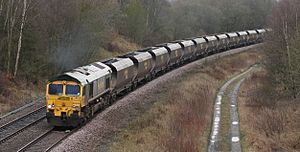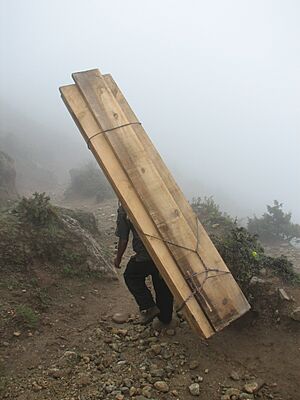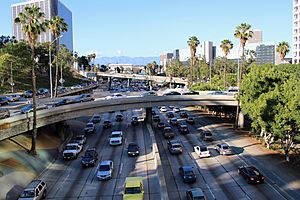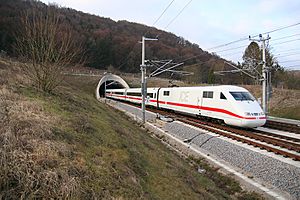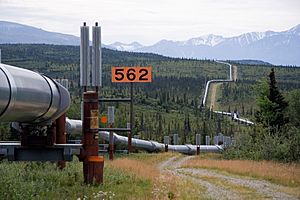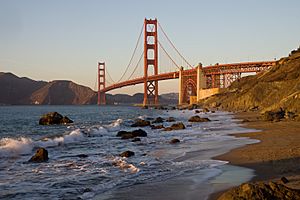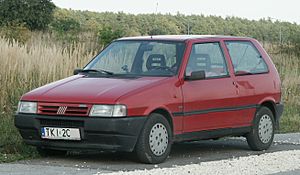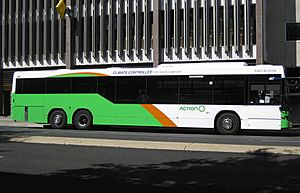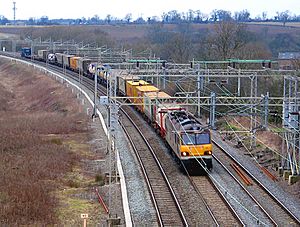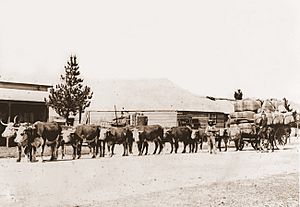Land transport facts for kids
Land transport is all about moving people, animals, and things from one place to another on land. Today, this usually happens using trains or roads.
Contents
How Land Transport Works
People have found many ways to move things on land. These ways range from simply carrying items to using complex networks of vehicles and roads. There are three main types of land transport: human-powered, animal-powered, and machine-powered.
Human-Powered Travel
Human-powered transport means moving people or goods using only human muscle power. This includes walking, running, or even swimming. Modern inventions have helped make human power even stronger.
People still use human-powered transport for many reasons. It can save money, be a fun hobby, offer good exercise, and is kind to the environment. Sometimes, it's the only way to get around, especially in remote areas.
Even though people can walk anywhere, roads make human-powered travel easier. This is especially true when using vehicles like bicycles or roller skates. Special human-powered vehicles have also been made for tough places, like snow (skis) or water (rowing boats).
Animal-Powered Travel
Animal-powered transport uses working animals to move people and goods. People might ride some animals directly. Other animals can carry goods on their backs, like pack animals. Animals can also be harnessed to pull sleds or wheeled vehicles.
Road Travel
A road is a clear path between two or more places. Roads are usually smooth or paved to make travel easy. Historically, many roads were just well-known paths without any special building or upkeep. In cities, roads are often called streets and serve as public spaces too.
The most common vehicle on roads is the car. Cars are wheeled vehicles that have their own engines. Other road users include buses, trucks, motorcycles, bicycles, and people walking. In 2002, there were about 590 million cars worldwide. Cars can cause air pollution, which can lead to health problems like asthma.
Road transport gives drivers a lot of freedom. They can change lanes or roads as needed. This flexibility in location, direction, speed, and timing is unique to road transport. It's also the only way to get true door-to-door service.
Cars offer great flexibility for small groups. However, they use a lot of energy and space. They are also a main source of noise and air pollution in cities. Buses can move more people efficiently, but they are less flexible. Trucks are often used for the first and last parts of a freight journey.
Rail Travel
Rail transport uses trains that run on two parallel steel rails. These rails are called a railway or railroad. The rails are held a certain distance apart by ties (also called sleepers) made of wood, concrete, or steel. The rails and ties sit on a base of concrete, or crushed earth and gravel. Other types of rail transport include monorails and maglev trains.
A train is made of one or more connected vehicles that move on the rails. Power usually comes from a locomotive. This engine pulls unpowered cars that carry passengers or goods. Locomotives can run on steam, diesel fuel, or electricity from tracks. Sometimes, all the cars in a train are powered, which is called a multiple unit. Trains can also be powered by horses, cables, gravity, or gas turbines.
Trains move with much less friction than rubber tires on roads. This makes trains more energy-efficient than cars, though not as efficient as ships.
Long-distance trains connect cities. Modern high-speed trains can travel up to 350 kilometers per hour (217 mph). But these trains need special tracks. Regional and commuter trains bring people from suburbs and nearby areas into cities. Within cities, trams and rapid transit systems (like subways) carry many people and are often the main part of a city's public transport.
Freight trains used to use boxcars, which needed people to load and unload cargo by hand. Since the 1960s, container trains have become popular for general goods. Large amounts of bulk materials, like ore or grain, are moved by special trains.
Other Ways to Transport on Land
Pipeline transport sends goods through a pipe. Most often, liquids and gases are sent this way. But pneumatic tubes can also send solid capsules using compressed air. Any stable liquid or gas can go through a pipeline. Short pipelines carry sewage, water, or even beer. Long pipelines are used for oil and natural gas.
Cable transport is a system where vehicles are pulled by cables instead of having their own engines. This is often used on steep hills. Examples include aerial tramways, elevators, escalators, and ski lifts. Some of these are also seen as conveyor transport.
Connecting with Other Transport Types
Airports
Airports are where air travel begins and ends. But most people and goods traveling by air need land transport to get to or from the airport.
Airports often have services to take people to nearby hotels if they need to stay overnight for connecting flights. Companies offer rental cars, private buses, and taxi services. Public transport, like city buses or trains, is usually provided by the local government.
Large airports, like Denver International and JFK International, offer many ground transport options. They often work with taxi companies and other businesses. Smaller airports might only have a few rental car companies and a bus service. Bigger airports sometimes have light rail or roads that loop around to connect different terminals.
Seaports
Just like with air travel, sea transport usually needs land transport at both ends of the journey. This helps people and goods get to their final destinations. Ports have a lot of special equipment to move people and goods between ships and land transport systems.
Parts of Land Transport
Infrastructure
Infrastructure means the fixed structures that allow vehicles to operate. This includes the path the vehicle travels, terminals, and places for parking and maintenance. For trains, pipelines, roads, and cable transport, the entire path must be built.
Terminals, like stations, are places where passengers and goods can switch from one vehicle or type of transport to another. For passengers, terminals combine different types of transport so travelers can easily change. For example, airport rail links connect airports to city centers. For cars, terminals are parking lots. Buses can use simple stops. For freight, terminals are places where cargo is transferred, though some goods go directly from where they are made to where they are used.
Building transport infrastructure can be very expensive. Governments often pay for roads, and sometimes railways and airports, using taxes. New projects are often paid for with borrowed money. Many infrastructure owners charge fees to use their facilities, like landing fees at airports or tolls on roads.
Vehicles
A vehicle is any non-living machine used to move people and goods. Unlike infrastructure, the vehicle moves along with its cargo and passengers. Unless pulled by a cable or muscle power, the vehicle needs its own engine. This is usually a steam engine, a combustion engine, or an electric motor. Vehicles also need a way to turn energy into movement, usually with wheels, propellers, or pressure.
Vehicles are most often driven by a person. However, some systems, like people movers and certain rapid transit trains, are fully automated. For passenger transport, the vehicle must have a space for the passengers. Simple vehicles, like cars or bicycles, might have one of the passengers as the driver.
Who Uses Land Transport?
Public Use
Public land transport means moving people and goods by government or commercial groups for everyone to use. This helps the economy and society. Most transport infrastructure and large vehicles are used this way. Money for public transport can come from taxes, subscriptions, user fees, or a mix of these. Most public transport is on land, mainly for daily commuting and mail delivery.
Commercial Use
Commercial land transport means businesses moving people and goods for a fee. They do this to make a profit. Most of the infrastructure they use is publicly owned. Their vehicles are usually large and efficient to carry as much as possible and earn more money. Freight shipping and long-distance travel are common uses for commercial land transport.
Military Use
Military land transport means the military or others moving people and goods to support military operations. This happens during peacetime and in war zones. They might use public roads or special military roads. Vehicles can be regular commercial ones or those made specifically for military use. They are often designed to work even where there are no roads.
Private Use
Private land transport is when individuals or groups move themselves, their own animals, or their own goods. They decide when and where to go. The vehicles used are usually smaller, and they often use publicly owned roads.
What Land Transport Does
Moving travelers and cargo are the main jobs of transport. But it also helps move armies during wars or construction and emergency equipment for civilians.
Moving People
Moving people, or travel, is split into public and private transport. Public transport has set schedules and routes. Private transport uses vehicles that offer services when a rider wants them. Private transport is more flexible but carries fewer people and has a bigger impact on the environment. People travel for daily commutes, business, fun, or when moving to a new place.
For short trips, cars and mass transit are most common. Mass transit includes buses in smaller towns and commuter trains, trams, and rapid transit in bigger cities. For long trips, people use cars, trains, buses, and airplanes. Airplanes are mostly used for the longest trips, including between continents.
Intermodal passenger transport means a journey uses several types of transport. Since all human travel usually starts and ends with walking, all passenger transport can be seen as intermodal. Public transport might also involve changing vehicles at a transport hub, like a bus or train station.
Taxis and buses are at different ends of public transport. Buses are cheaper but less flexible. Taxis are very flexible but more expensive. Somewhere in the middle is transport that offers flexibility while still being affordable.
Sometimes, international travel can be limited for people due to laws and visa rules.
Moving Goods (Freight)
Moving goods, or shipping, is a very important part of making and selling products. As things are made in more specialized places and the world becomes more connected, the need for transport has grown a lot. All types of transport are used for cargo, but the choice depends on the type of goods. Logistics is the whole process of moving products from where they are made to where they are used. This includes storage, transport, transferring goods, and packaging.
Containerization has changed international and local trade. This means using standard-sized containers on all vehicles and at all ports. It has greatly reduced the cost of transferring goods. Before, all cargo had to be loaded and unloaded by hand. Containers allow for automated handling and easy transfer between different types of transport. Their standard sizes also help save money when operating vehicles. This has been a key reason for the growth of international trade and globalization since the 1950s.
Bulk transport is used for goods that can be handled roughly without damage. Examples include ore, coal, grains, and oil. Because these products are uniform, machines can move huge amounts quickly and efficiently. Since these goods are low in value but high in volume, it's important to move them in large quantities to save money. Whole trains are often used for bulk transport. Liquid products in large amounts can also be moved by pipeline.
History of Land Transport
The first way humans traveled on land was by walking. Then, people started taming animals. This gave them a new way to carry heavier loads or ride animals for faster and longer journeys. Inventions like the wheel and sled made animal transport even better by using vehicles. However, before the Industrial Revolution, water transport (boats) was the only efficient way to move large amounts of goods or travel long distances.
The first forms of road transport involved horses, oxen, or even humans carrying goods on dirt paths. These paths often followed animal trails. Many early civilizations, like those in Mesopotamia and the Indus Valley, built paved roads. The Persian and Roman empires built stone-paved roads for their armies to travel quickly. These roads had deep layers of crushed stone to keep them dry. Later, the medieval Caliphate built roads paved with tar. Until the Industrial Revolution, transport was slow and costly. So, things were made and used as close to each other as possible.
The Industrial Revolution in the 19th century brought many inventions that completely changed transport. With the telegraph, communication became instant and didn't depend on transport. The invention of the steam engine, and its use in trains, made land transport independent of human or animal muscles. Both speed and carrying capacity grew quickly. This allowed factories to be built anywhere, not just near natural resources.
With the invention of the combustion engine and the car around 1900, road transport became much more practical. This led to the rise of private mechanical transport. The first highways were built in the 19th century using macadam. Later, tarmac and concrete became the main paving materials.
After World War II, cars and airplanes became more popular for transport. This reduced the role of trains to mainly freight and short-distance passenger travel. In the 1950s, the use of containers greatly improved efficiency in freight transport, helping globalization grow. International air travel became much easier in the 1960s with the invention of the jet engine. Along with more cars and highways, this led to a decline in train travel. However, after the Shinkansen (bullet train) started in Japan in 1964, high-speed rail in Asia and Europe began taking passengers on long-distance routes away from airlines.
Images for kids
See also
 In Spanish: Transporte terrestre para niños
In Spanish: Transporte terrestre para niños


